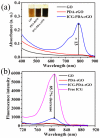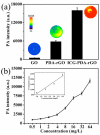Indocyanine Green-Loaded Polydopamine-Reduced Graphene Oxide Nanocomposites with Amplifying Photoacoustic and Photothermal Effects for Cancer Theranostics
- PMID: 27217837
- PMCID: PMC4876628
- DOI: 10.7150/thno.14566
Indocyanine Green-Loaded Polydopamine-Reduced Graphene Oxide Nanocomposites with Amplifying Photoacoustic and Photothermal Effects for Cancer Theranostics
Abstract
Photoacoustic (PA) imaging and photothermal therapy (PTT) as light-induced theranostic platforms have been attracted much attention in recent years. However, the development of highly efficient and integrated phototheranostic nanoagents for amplifying PA imaging and PTT treatments poses great challenges. Here, we report a novel phototheranostic nanoagent using indocyanine green-loaded polydopamine-reduced graphene oxide nanocomposites (ICG-PDA-rGO) with amplifying PA and PTT effects for cancer theranostics. The results demonstrate that the PDA layer coating on the surface of rGO could effectively absorb a large number of ICG molecules, quench ICG's fluorescence, and enhance the PDA-rGO's optical absorption at 780 nm. The obtained ICG-PDA-rGO exhibits stronger PTT effect and higher PA contrast than that of pure GO and PDA-rGO. After PA imaging-guided PTT treatments, the tumors in 4T1 breast subcutaneous and orthotopic mice models are suppressed completely and no treatment-induced toxicity being observed. It illustrates that the ICG-PDA-rGO nanocomposites constitute a new class of theranostic nanomedicine for amplifying PA imaging and PTT treatments.
Keywords: Indocyanine green; Photoacoustic imaging; Photothermal therapy.; Reduced graphene oxide; Theranostics.
Conflict of interest statement
Competing Interests: The authors have declared that no competing interest exists.
Figures









Similar articles
-
Hybrid MoSe2-indocyanine green nanosheets as a highly efficient phototheranostic agent for photoacoustic imaging guided photothermal cancer therapy.Biomater Sci. 2018 May 29;6(6):1503-1516. doi: 10.1039/c8bm00104a. Biomater Sci. 2018. PMID: 29633765
-
Chemotherapeutic drug-photothermal agent co-self-assembling nanoparticles for near-infrared fluorescence and photoacoustic dual-modal imaging-guided chemo-photothermal synergistic therapy.J Control Release. 2017 Jul 28;258:95-107. doi: 10.1016/j.jconrel.2017.05.011. Epub 2017 May 10. J Control Release. 2017. PMID: 28501673
-
Indocyanine green-loaded polydopamine-iron ions coordination nanoparticles for photoacoustic/magnetic resonance dual-modal imaging-guided cancer photothermal therapy.Nanoscale. 2016 Oct 21;8(39):17150-17158. doi: 10.1039/c6nr05502h. Epub 2016 Aug 19. Nanoscale. 2016. PMID: 27539790
-
Organic Nanotheranostics for Photoacoustic Imaging-Guided Phototherapy.Curr Med Chem. 2019;26(8):1389-1405. doi: 10.2174/0929867324666170921103152. Curr Med Chem. 2019. PMID: 28933283 Review.
-
Functionalized theranostic nanocarriers with bio-inspired polydopamine for tumor imaging and chemo-photothermal therapy.J Control Release. 2019 Sep 10;309:203-219. doi: 10.1016/j.jconrel.2019.07.036. Epub 2019 Jul 27. J Control Release. 2019. PMID: 31362077 Review.
Cited by
-
pH-sensitive and bubble-generating mesoporous silica-based nanoparticles for enhanced tumor combination therapy.Acta Pharm Sin B. 2021 Feb;11(2):520-533. doi: 10.1016/j.apsb.2020.08.013. Epub 2020 Sep 2. Acta Pharm Sin B. 2021. PMID: 33643828 Free PMC article.
-
Conjugated Organic Photothermal Films for Spatiotemporal Thermal Engineering.Adv Mater. 2021 Nov;33(47):e2005940. doi: 10.1002/adma.202005940. Epub 2021 May 29. Adv Mater. 2021. PMID: 34050686 Free PMC article. Review.
-
Enhanced wound repair ability of arginine-chitosan nanocomposite membrane through the antimicrobial peptides-loaded polydopamine-modified graphene oxide.J Biol Eng. 2021 May 22;15(1):17. doi: 10.1186/s13036-021-00268-3. J Biol Eng. 2021. PMID: 34022941 Free PMC article.
-
Progress in the Development of Nanotheranostic Systems.Theranostics. 2016 May 19;6(7):915-7. doi: 10.7150/thno.16153. eCollection 2016. Theranostics. 2016. PMID: 27217827 Free PMC article.
-
State of the Art in Carbon Nanomaterials for Photoacoustic Imaging.Biomedicines. 2022 Jun 10;10(6):1374. doi: 10.3390/biomedicines10061374. Biomedicines. 2022. PMID: 35740396 Free PMC article. Review.
References
-
- Cheng L, Liu J, Gu X, Gong H, Shi X, Liu T. et al. PEGylated WS(2) nanosheets as a multifunctional theranostic agent for in vivo dual-modal CT/photoacoustic imaging guided photothermal therapy. Adv Mater. 2014;26:1886–93. - PubMed
-
- Liu J, Zheng X, Yan L, Zhou L, Tian G, Yin W. et al. Bismuth sulfide nanorods as a precision nanomedicine for in vivo multimodal imaging-guided photothermal therapy of tumor. ACS Nano. 2015;9:696–707. - PubMed
-
- Liang X, Li Y, Li X, Jing L, Deng Z, Yue X. et al. PEGylated polypyrrole nanoparticles conjugating gadolinium chelates for dual-modal MRI/photoacoustic imaging guided photothermal therapy of cancer. Adv Fun Mater. 2015;25:1451–62.
Publication types
MeSH terms
Substances
LinkOut - more resources
Full Text Sources
Other Literature Sources
Medical

